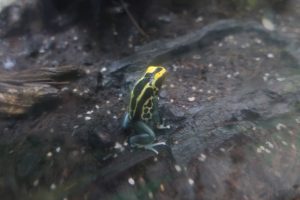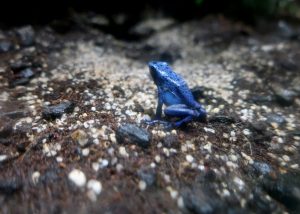Species Highlight: Poison Dart Frog
Poison dart frogs got their moniker from indigenous Central and South Americans using the toxins the animals secrete through their skin on hunting arrows. We talked to aquarist Connor Craig to learn more about some of the Greater Cleveland Aquarium’s newest (and deadliest) residents.
Poison dart frogs can be found in nature in the humid rainforests of Central and South America. Their vivid coloring is a form of protection from would-be predators. “A poison dart frog’s bright color advertises the fact that it’s poisonous, so they don’t get eaten,” says Craig adding that although darts frog come in a variety of hues, their color doesn’t correlate to how poisonous they are.
Their deadly poison comes from the frog’s diet of different small insects like ants, small flies and beetles. In the Aquarium, the poison dart frogs eat fruit flies, pinhead crickets and a vitamin supplement to ensure proper nutrition. “The controlled diet doesn’t allow for the development of the poison for which these animals are known,” says Craig.
The only natural predator of the poison dart frog is the fire-bellied snake (Leimadophis epinephelus), which has developed a resistance to the frog’s poison. However, the biggest problems facing poison dart frogs are related to human activity. “One of the first signs that something is wrong in an ecosystem is if indicator species, such as amphibians, start to decline,” Craig says. “Many species of amphibians are threatened from human activities like deforestation, the pet trade and deteriorating water quality.”
While deadly, imagine if their poison could be used to make someone feel better. Scientists are using the toxins blue poison dart frogs secrete to study how nerves conduct electricity to help them create new human painkillers.
Get an up-close look at green and black, Patricia dyeing and ‘Azureus’ blue dart frogs on your next visit to the Greater Cleveland Aquarium. Nature. It’s a curious thing.
– Hannah
